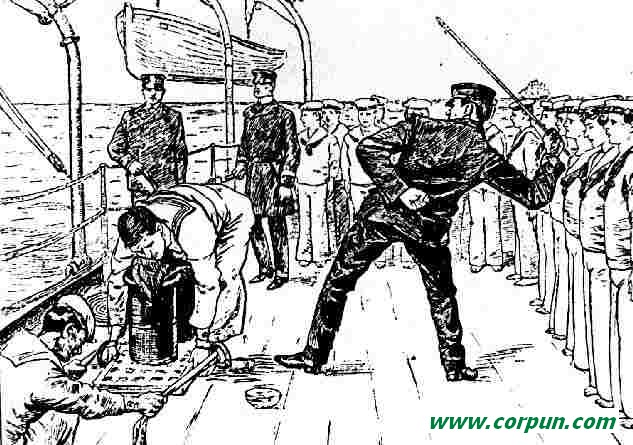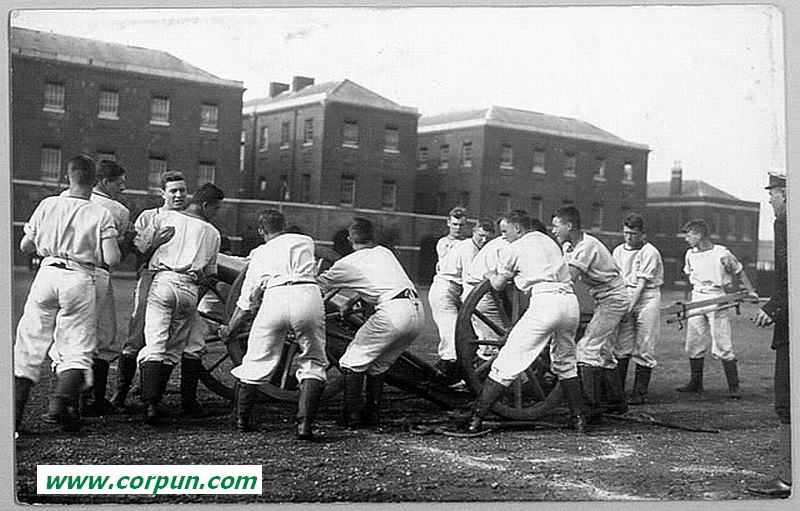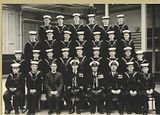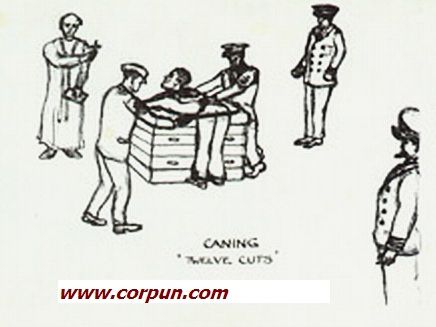Until the 1860s, sailors could be flogged on board ship by order of the captain. The punishment was administered with a cat-o'-nine-tails. Boys (under-18s) were flogged on the bare buttocks. For adult men it was normally applied to the bare upper back, but sometimes a sailor seen to have misbehaved in a particularly childish manner, or who was "too big for his boots", would be ordered to be "punished as a boy". Typically there would be a formal punishment ceremony in front of the assembled ship's company ("all hands on deck to witness punishment"), with the recipient tied up to a grating (pictured left).
Flogging with the "cat" gradually came to be seen as unduly brutal. It was much reduced in frequency and severity by the middle of the 19th century, with two or three dozen lashes the norm compared with hundreds of lashes in the 18th century. It was suspended in 1881 (except in naval prisons) and never resumed, though CP for adult sailors was not formally removed from the statute book until 1949.

Drawing of pre-1906 naval "cuts" in progress, published by the Humanitarian League, which was campaigning against CP in the Navy. The "defaulter" is being held, by means of ropes threaded though the ring-bolts, bending low over the bitts (ship's bollards). The drawing is a little inept: the boys mustered to witness the punishment are shown as standing much too close, not leaving enough room for the ship's corporal to swing his cane. Also the cane is too big: in that era it should have been just 3 feet long.
Note also that the almost doubled-over posture shown here is a tighter one than that which became the norm on the training ships, where a 90-degree bend was found most effective (see drawing at top of this page), given the already taut fit of the white duck trousers required to be worn by the young man under punishment. The 90-degree position also enabled the lower half of the buttocks to be more accurately targeted than would have been possible with the method shown here. |
From the 1860s onwards, boy sailors were birched instead of flogged with the cat (see articles linked below). For lesser offences they could be caned "on the breech with clothes on", in earlier times in front of all the boys, but since 1906 in private. A great parliamentary campaign was mounted against birching, as a result of which it was abandoned in 1906 as a regular summary punishment, though it survived until the 1930s as a court-martial penalty, a rare and grave event: the last known birching was in 1936, at Portland.
It was not quite the last birching sentence, however. In 1940 two 17-year-olds on HMS Columbo were sentenced by court-martial to 18 strokes of the birch each for indecency with each other. But their ship was in the Middle East, and no birch was to hand. To save time waiting for birches to arrive through the fog of war, permission was given by telegram from London for the "award" to be modified to 12 strokes of the cane each, which were administered forthwith at the naval base in Aden. (PRO 11312/15 and 1507/17, 15 July 1940.)
Caning in private thus from 1906 superseded birching as the main serious punishment for juniors. Some observers have asserted that the cane, as administered in the Navy, was actually the more painful instrument. In 1900 there had been 315 birchings, and in 1904 only 200; but in 1909 there were 1,500 canings, accounting for some 30% of all the boys in the Navy.
The cane could be used on board any ordinary ships at sea that had under-18s embarked, but it came particularly into its own on naval training "ships", which in the early 20th century became huge land-based establishments like HMS Ganges (1905-1940 and 1945-1975), on the Suffolk coast, containing many hundreds of youths between 15 and 18. These institutions became renowned for exceptionally tough discipline, enforced by frequent resort to severe formal canings. Boys joined on leaving school, and were usually there for a little less than two years (only one year, in later times). Statistics for the 1930s indicate some 200 official canings per year on HMS Ganges alone, an average of four per week.
Offenders, known in the Navy as "defaulters", were mustered every morning and went before the Commandant for a formal hearing, where if aged under 18 they could be "awarded" either 6 or 12 "cuts" with a heavy cane, administered that same day with maximum force and much ceremonial ritual by burly and skilful ship's police or Master-at-Arms.
Before receiving his punishment, the youth would be given a medical inspection ("the boy's buttocks are examined and his general physical condition observed" -- Admiralty, 1950). He was then marched to the ship's tailor to be fitted into a pair of extra-thin tropical-weight white duck trousers, with -- at least on HMS Ganges -- no underwear allowed. (The Admiralty wrote in 1950 that the latter provision "allows the strokes of the cane to be as painful as need be". They seem not to have been following their own rules, because the King's Regulations in 1943 had amended the wording to "Caning on the breech, duck trousers with pants being worn" ['pants' here meaning 'underwear'], but perhaps this was intended to apply only to seagoing ships and not the training ships.)
According to several accounts, the punishment ducks kept in a range of sizes by ship's tailors for this purpose were specially worn-out ones, rubbed threadbare at the seat with years of use. However, by the 1950s the Admiralty was claiming this was not, or was no longer, the case, at least at HMS Ganges:
"The allegation that the trousers Beaumont was made to put on for his canings were torn and threadbare is unfounded. The punishment duck trousers kept in the Guardhouse for such purposes have been inspected and the material that covers the buttocks were [sic] seen to be in good condition". (ADM 1/262226, 28 September 1953.)
White ducks were baggy in the legs but quite snug-fitting around the groin and lower torso so that, when the wearer was ordered to bend over, the flimsy fabric would be drawn smooth around the behind and up into the crotch, tautening the buttocks and accentuating the lower part of the seat. Thus the effectiveness of the caning was maximised while still satisfying the legal "with clothes on" requirement.
The ceremony was elaborate, slow and solemn. The miscreant stood to attention while the offence and punishment were formally read out, and he was then tied or held bending across a desk, field gun, gym horse or bitts. With as much as one minute elapsing between strokes, the whole procedure could take 20 minutes per boy. The cane was a Nilchert rattan, 40 inches long and half an inch in diameter, bound with cord in two or three places to prevent splitting (information from official Admiralty correspondence in 1950). This is actually longer by 4 inches than it had been in 1906 (ADM 1/7865). It was about twice the thickness of the typical secondary-school cane, but then its "customers" were mostly aged 16 or 17 -- two or three years older than most schoolboy recipients at the time. (A thicker instrument would bruise more, but lacerate less, than a thinner one.) According to some accounts, the rattan was soaked beforehand in linseed oil to make it heavier and more supple.
|

Picture credit: Royal Naval Museum
Teenagers on field-gun practice at the boys' training ship HMS St Vincent, Gosport, Hampshire, in 1930. The photograph is not about CP, but it shows how the white duck trousers would closely hug a youth's rump, making them an ideal garment for the caning ritual -- although the ducks kept specially for punishment purposes would be thinner than these, according to some sources.
By the way, Admiralty documents reveal that in this period HMS St Vincent was meting out corporal discipline at an even higher frequency pro rata than HMS Ganges: almost half (48.3%) of St Vincent's c.500 trainees were "awarded cuts" in 1929 (ADM 178/74). So it is not fanciful to suppose that some five or six of the lads seen here would already, by the time this photo was taken, have found themselves stretched over the vaulting-horse for a bruising session with the half-inch-thick rattan, or could look forward to undergoing that ordeal in the coming months. |
A sore, heavily bruised and wealed backside was the inevitable and intended consequence of this form of discipline. The weals typically lasted at least 14 days. Sitting down would be very uncomfortable for a while, especially as ship's police were trained to aim the cane at the area between the horizontal centre of the posterior and the gluteal crease. There is anecdotal evidence that boys were sometimes allowed to take their meals standing up for a day or so after receiving cuts.
Particularly after a maximum caning of 12 strokes, there could be superficial bleeding where cuts had crossed over each other, according to some accounts. All recipients who have commented on the matter seem to agree that the experience was not one they ever wished to risk repeating. Several accounts describe boys emerging from the punishment room after "12 cuts" scarcely able to walk, dazed with pain and shock. Antiseptic lotion would be applied in the sick-bay afterwards as necessary.
The Brock Committee on Naval Discipline in 1912 found that "strict discipline and unfailing obedience are more essential than ever" in the modern Navy, and that "caning is by far the most suitable punishment for boys".
In 1931 the Admiralty noted that, while caning was severe, it was soon over, and caused no permanent physical injury, and that other punishments, such as "extra work" or confinement to quarters, would be likely to be more harmful.
Some of the descriptions of naval punishments put about by those campaigning for reform were most likely exaggerated. For a rare eyewitness account by a more dispassionate observer of two 16-year-olds undergoing routine corporal punishment on board a real seagoing ship (in this instance, the 700-man battleship HMS Jupiter), one (3 cuts) for smoking and the other (6 cuts) for insolence and neglect of duty, see this Aug 1903 report from the respected journalist A.G. Hales in the London Daily News:
The prisoner who has been smoking comes forward, hitches his pants ['pants' here meaning 'trousers'], and throws himself across the gun upon his stomach; his head hangs down one side, his feet on the other. A couple of men kneel by his head and take a wrist and an ankle each and draw them together so that the trousers fit very taut in the most prominent place. The corporal throws himself into a striking attitude. Evidently this is to be no child's play. Swish! That boy would give every cigarette in his possession to be able to rub the spot where the cane has fallen, but he can't rub, he can only writhe and wait for the next. [...]
The corporal is in no hurry. The first stroke had been a sort of overhead and downward cut. This second one -- whew! -- swish! It comes underhand and upwards. [...] Whizz! -- slosh! A straight forearm cut fair across the other two lines. The men let his hands and feet go, he springs erect with flushed face and suspiciously brilliant eyes, and trots off to his duties.
Hales's matter-of-fact description reminds us that caning at that time was regarded as a relatively minor punishment, and he explicitly compares it to a schoolboy's swishing, albeit a severe one. But it seems likely that the procedure may have been deliberately made more severe than this after 1906, when it became applicable for more serious crimes, previously punished with the birch.
Some first-person accounts of canings on training ships are to be found under external links, below. At these establishments (but not on board seagoing ships), there was a minimum of six "cuts" per punishment as well as the maximum of 12.
The designation "boy" was abolished in 1955 and they became "junior seamen". A little-known fact is that at this point the Admiralty actually wanted to extend caning to all naval ratings aged under 17½ throughout the Fleet, whether "rated as boys" or not. This would seem fair and equitable, but the navy chiefs were told that such a move would be politically unacceptable (ADM 1/26291). Caning on board real ships at sea was therefore quietly phased out. The boys' training ships, however, continued to cane until 1967. Abolition was forced by the Labour government on a reluctant Admiralty, which had only earlier that year declared that it had no intention of abandoning such a useful and efficacious practice. There were 69 canings in the final 12 months, mostly for stealing, absconding ("desertion") or assault, accounting for 3.3% of juniors enlisted at the two training ships then remaining (Ganges and Fisgard).
NOTE: All the above relates only to ratings, i.e. ordinary seamen. Junior officers, a.k.a. cadets or midshipman, could be and were also caned (e.g. "Official cuts" at Dartmouth Naval College) and, in earlier times, birched, but not under the Naval regulations -- they had their own separate rules and customs.
 See also this cartoon about caning at HMS Ganges.
See also this cartoon about caning at HMS Ganges.
DOCUMENTS:
Kissing the Gunner's Daughter, Part I: 1780-1860 (illustrated)
First part of a feature article on the flogging of boy seamen.
Kissing the Gunner's Daughter, Part II: The 1860s Ryder reforms (illustrated)
The birch replaces the cat for navy boys.
Extracts from 19th-century ships' logbooks
Sample entries recording public floggings of young sailors.
Extracts from evidence at a 1861 Court Martial
Excessive canings of boy seamen described.
Extracts from Queen's Regulations and Admiralty Instructions 1879
Official rules for the birching and caning of boys in the Royal Navy.
Extracts from Ship's Logs - HMS Victory 1867/8
Records of the first birchings of boys after the birch replaced the cat.
Royal Navy - Glossary
Some technical terms explained.
Caning of Royal Navy Boys in the 1920s
A 1931 internal government report discusses the frequency of corporal punishment for boy seamen under training, and whether it was being used excessively. Quotes from the regulations in force at the time.
Statistical table
Appendix to the above report, setting out figures for the incidence of caning in different ships and training establishments.
Report of a Court Martial
Details of the punishment of a 17-year-old boy seaman in 1813.
EXTERNAL LINKS: (these will open in a new window) 
 Sober men and true: Sailor lives in the Royal Navy, 1900-1945
Sober men and true: Sailor lives in the Royal Navy, 1900-1945
See pages 40 to 44 of this 2002 book by Christopher McKee. Descriptions of caning and birching of junior seamen.
Supply (Navy Estimates).
House of Commons debate in March 1905. Veteran Irish MP and dogged anti-CP campaigner Swift MacNeill makes a long speech against the birching of boys in the Navy.
Kings Regulations and Admiralty Instructions
Here are the UK Royal Navy's regulations in their 1913 version (cf. the 1879 version). Scroll down to the second table of summary punishments and also to paragraph 760 to see that corporal punishment in the form of lashes (with the cat) was still theoretically lawful for mutiny, but, as explained in the footnote, this punishment had in practice been suspended (and it was never to be restored).
The birching of boys on the bare breech (see paragraph 799) had also been suspended, in 1906; it was to be reintroduced a few years later, but only by court martial (and only for homosexual behaviour), not for use as a summary punishment.
"Caning on the breech with clothes on" (max. 12 cuts) was, however, still available as a routine summary punishment for sailors under 18 -- see row 19 of the table and paragraph 799 -- and, as we know from many sources, was being administered frequently at this period.
 HMS St Vincent Boy/Junior Training Establishment 1927 - May 1966
HMS St Vincent Boy/Junior Training Establishment 1927 - May 1966
HMS St Vincent was a naval training "ship" at Gosport (England) for newly recruited junior seamen. Here we learn that the punishment of caning was known in the 1950s as getting "a Japanese sunset across your backside".
Further down the page, the establishment's Captain in 1956 is quoted as saying that if he awarded corporal punishment it was to be carried out by the Master-At-Arms within half an hour, after a medical check. He never ordered more than the minimum six cuts for a first offence, and recalls "boys before me with tears in their eyes, begging me to award them the cane instead of stopping that precious one afternoon's leave a week".
H.M.S. Ganges: Tales of the Trogs
Review of a book of anecdotes about legendary UK boys' naval establishment HMS Ganges, which at any one time housed as many as 2,000 trainee sailors in their middle teens. Several tales about bullying and the harsh regime generally, not so much about the famous and frequent official canings. Unfortunately this page is very badly presented and it is impossible to work out which paragraphs are quotes from the book and which are comments by the reviewer.
A Shotley Boy
Autobiographical account of life at HMS Ganges in the 1930s. Describes receiving twelve official cuts with the cane.
H.M.S. Ganges 1821-1899
History of the early days of HMS Ganges, when it really was a ship. Discipline was harsh, and in 1866 there was a scandal about birching.
 Other external links for Naval CP
Other external links for Naval CP
(Note: most of these, where they relate to the UK, are about so-called "training ships" not run by the Navy itself. These were often essentially reformatories, mostly for rather younger boys than the Navy establishments, and are not covered by the article above, though many of them did run quite similar regimes as far as CP was concerned. For one (incomplete) attempt at classifying different kinds of establishment, see this page . The situation is extremely confusing, but my understanding is that only those "ships" whose names were prefaced with "HMS" were part of the real Navy.)
. The situation is extremely confusing, but my understanding is that only those "ships" whose names were prefaced with "HMS" were part of the real Navy.)






